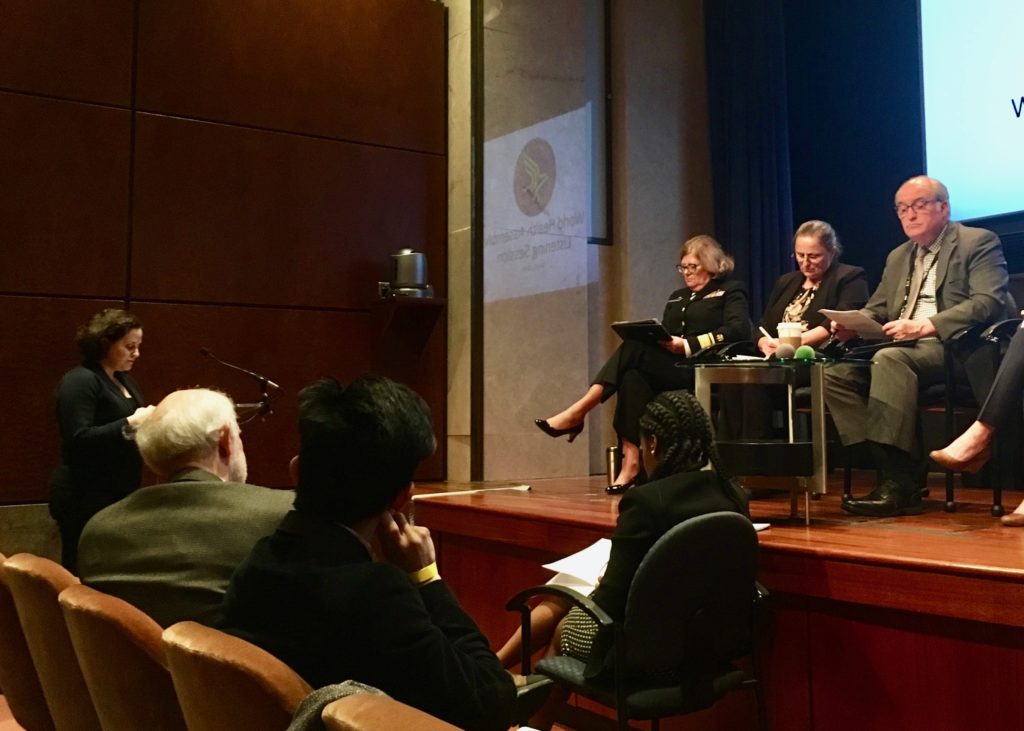Preparing US Gov’t for 2019 World Health Assembly
6 May 2019 – TogetHER’s Executive Director, Celina Schocken, gave remarks today to representatives from various U.S. Government departments who are preparing to participate in the World Health Assembly later this month. The 72nd Session of the World Health Organization’s (WHO) World Health Assembly will take place in Geneva, Switzerland from 20 – 28 May 2019.

Executive Director’s remarks:
On behalf of TogetHER for Health, a global cervical cancer organization, I would like to offer comments on WHA agenda item 11.8, namely the follow-up to last year’s UNGA High-Level Meeting on non-communicable diseases.[1]
TogetHER for Health works with health care providers, advocates, donors, and policy makers toward ending the estimated 311,000 annual global deaths from cervical cancer,[2]the great majority of which are in low-resource settings.
We are encouraged that the WHO Secretariat seeks to “fast-track health outcomes” by scaling up initiatives that include cervical cancer elimination, which was identified as a goal by the Secretary General one year ago. And we applaud member states’ commitment[3]to promote access to affordable tools as part of a comprehensive approach to prevention and control of cervical cancer.
However, the positive rhetoric has not been accompanied by sufficient action. I urge you to hold WHO accountable for implementing its vision. Women are dying of cervical cancer while we wait for scale-up of existing and new tools to fight the disease.
For example, we have been waiting for more than four years for WHO to update its guidance on the treatment of cervical precancer to include Thermal Coagulation as a tool for preventing cervical cancer. A nurse from Ghana recently described a concern we hear repeatedly from medical providers: her team prefers thermal coagulation over the alternative of cryotherapy, because it is a much quicker treatment; cryotherapy gases can be difficult to keep in stock; and the gas canisters “are huge and difficult to carry around,” in her words, to community sites where they offer screening and treatment.
Thermal coagulation is a widely accepted and powerful tool to prevent cervical cancer, yet most health ministries are waiting for the WHO recommendation to invest in it. WHO’s delay is therefore costing the lives of women who cannot receive treatment for their cervical pre-cancer because, for example, a clinic has difficulty stocking gas for cryotherapy. I ask you to convey to WHO that that is entirely unacceptable.
WHO should also take responsibility for ensuring countries have the funds to scale up other tools that can move us along the path to cervical cancer elimination, like tests for the HPV virus that causes most cases of cervical cancer, and mobile colposcopes with cameras. Scaling up mobile colposcope use also paves the way for implementing Automated Visual Evaluation (AVE), a new machine learning tool with amazing potential for instant, accurate diagnoses. In the first studies, AVE was more effective than pap smears, for a fraction of the cost.
The global health community is headed in the right direction to address the burden of cervical cancer. Please emphasize to WHO and its member states that elimination is an achievable goal if attention and resources are invested at scale. The path forward is clear, and WHO must lead with greater urgency.
[1]Documents A72/19 and EB144/2019/REC/1, decision EB144(1)
[2]Bray F, Ferlay J, Soerjomataram I, Siegel RL, Torre LA, Jemal A (2018). Global Cancer Statistics 2018: GLOBOCAN Estimates of Incidence and Mortality Worldwide for 36 Cancers in 185 Countries. CA Cancer J Clin. Available at: https://onlinelibrary.wiley.com/doi/full/10.3322/caac.21492
[3]United Nations General Assembly resolution 73/2
